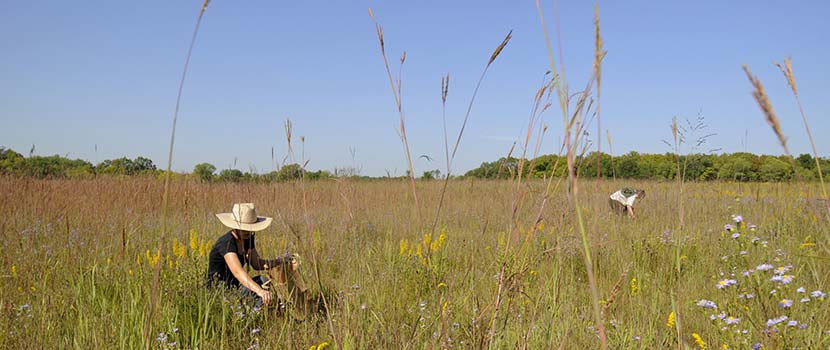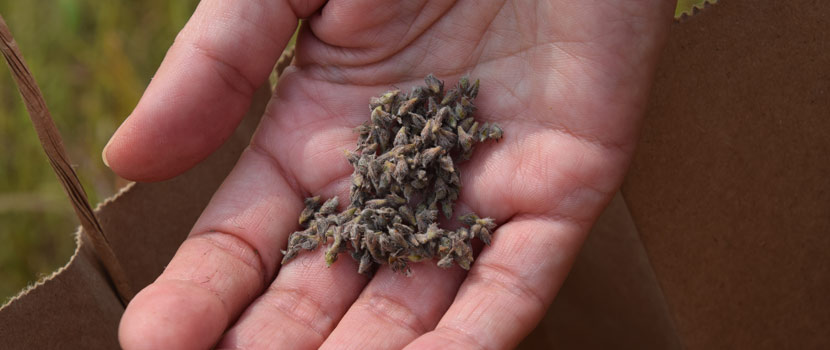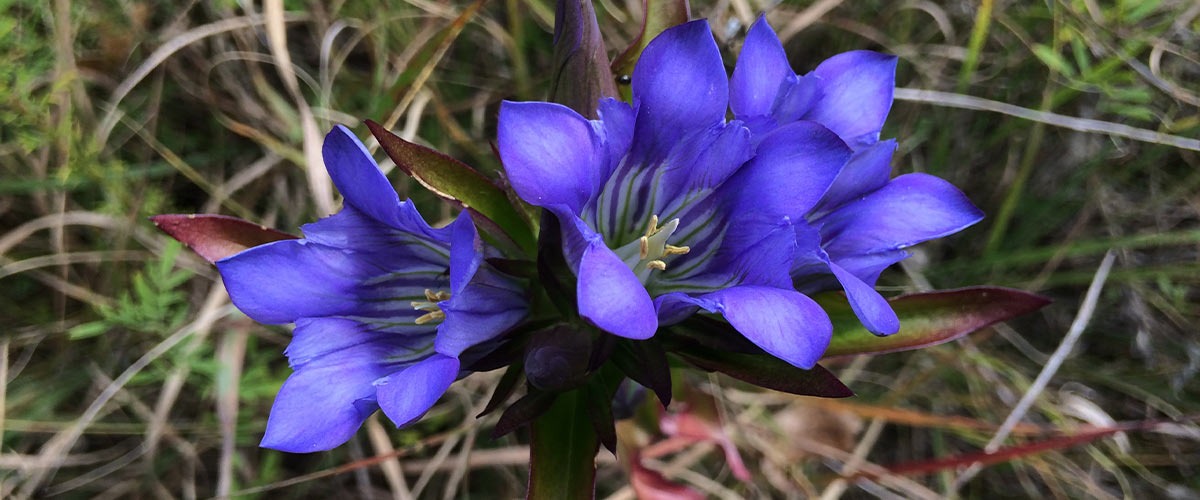
The Unique Plants of Our Restored Prairies
By: Angela Grill
November 02, 2020
Category: Resource Management
In a job interview we are prepared for the question “What makes you unique?” This is not usually an opportunity to confess weird habits or hobbies during the interview, but instead a chance for us to say what makes us the best candidate for a job. It may seem like a stretch but when it is time for collecting prairie seed, we are seeking plants that fit the job of being unique to supporting diversity and resiliency.
Some species are common and easily located, with staff and volunteers simply filling grocery bags full of fine delicate seed. However, there are other species that require a treasure hunt of sorts to relocate after blooming and become the uniquely high-valued seed. Almost like searching for buried treasure except this prize is above ground and so very tiny.
What makes these prairie species so valuable to our restoration efforts? Is it their uniqueness or simply their rarity? We will let you read on to be the judge.
While in the past we have featured some of our common species of the restored prairies, let us now take time to visit the unique plants. These are often highly valued seed that can be difficult to collect and we take great pride in having them present in our prairies.
Hand collecting from various locations across the Park District, we share our top ten:
1. American Pasqueflower

With snow still on the ground, this is our earliest blooming flower in the prairie. Staff take great pride in this delicate lavender flower because it was not an easy feat to locate seed in the early stages of restoration.
After many years of patience and hand collecting seed to move around in the prairies, one can spot this spring beauty right from the hiking trails.
2. Wood Betony
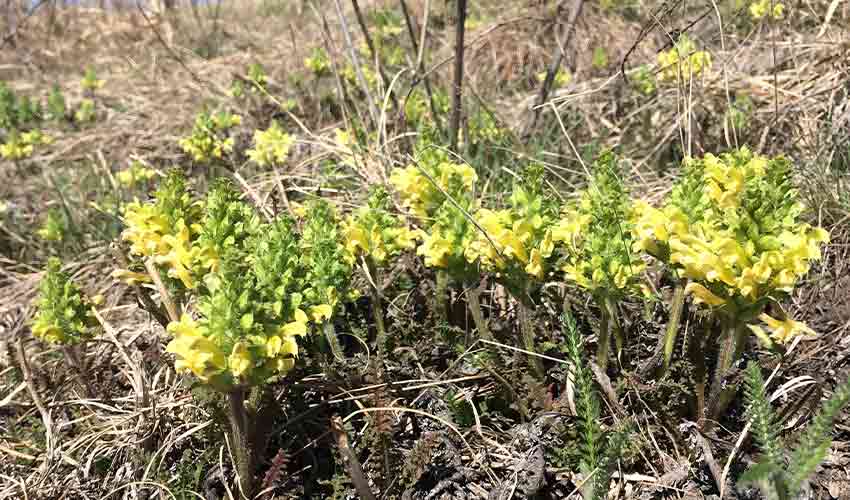
Another spring favorite and unique looking flower of the prairie is the Hemiparasitic species wood betony. Often an important nectar and pollen source for emerging queen bumble bees, this yellow bloom looks like a pinwheel from the top.
Not only can this plant attach to host plants (often grasses) to acquire water and nutrients, but after flowering, its seed capsules disperse seed through explosive mechanisms. Seed collection of this species is all about timing!
3. Prairie Violet
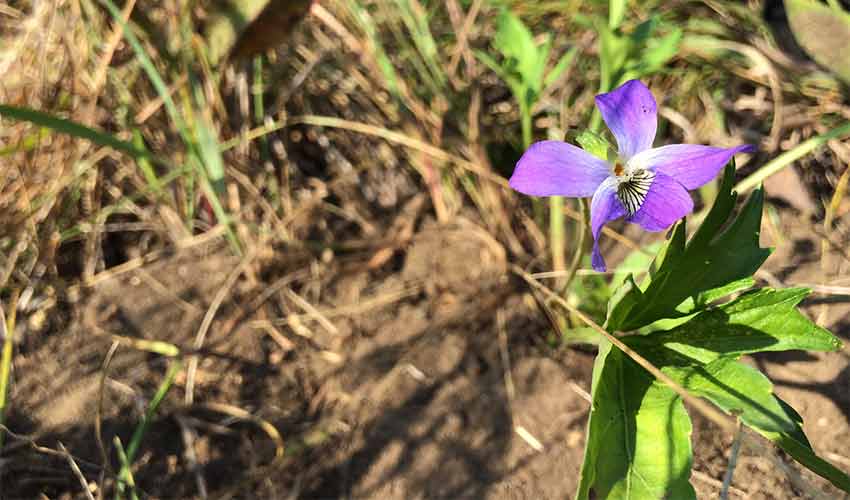
Hand planted into the prairies of Crow-Hassan is a tiny deep purple to blue flower that took years to establish healthy populations for the reintroduction of a special butterfly called the Regal Fritillary.
The prairie violet serves as a host plant for the caterpillars of the Regal Fritillary and staff spent years hand planting thousands prior to the successful reintroduction. This dainty yet important flower has a unique trait of seed production where they can produce closed, self-pollinating flowers or cleistogamous flowers.
4. Porcupine Grass

Grass is easily overlooked but there are some plants you just cannot miss, including this sharp to handle porcupine grass. This bunch grass has specialized florets that can self-plant. The needle-sharp floret can easily pierce skin and you will feel this grass seed when stuck in your pant leg.
This feature allows the seed to orient to the soil when dropped, and then the stiff bristle attached to the seed coils when dry and uncoils when wet, working the seed into the ground. Hand collected by staff in June, this seed needs to be quickly dispersed before it becomes a tangled mess in the collection buckets.
5. Downy Gentian

This deep blue-violet flower is a late bloomer, emerging in August and September with the flowers opening in the morning and then closing at night.
Other Gentian species of our prairies at Three Rivers stay closed, with bumble bees almost exclusively pollinating them because they are the only ones strong enough to pry open the closed flowers. Downy Gentian prefers drier conditions than our other common Gentians making this a rare find in the prairies.
7. Long-leaf Bluets
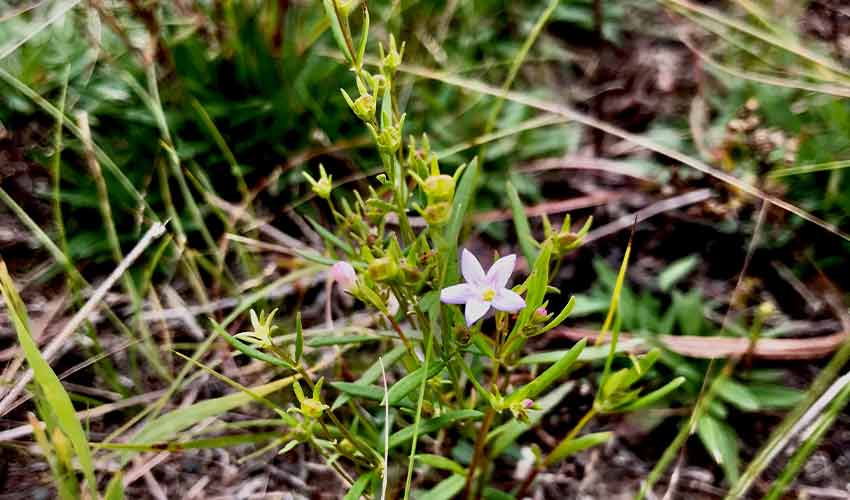
Tiny and easily overlooked, this 4-petaled flower is a joy to find blooming with its white to pink to pale blue color. The flower is only half an inch in size and pollinated primarily by small bees, including Halictid bees, masked bees, little carpenter bees and mason bees.
Seeds are even smaller – hand collection takes patience and collectors have to get very low to the ground. This wildflower is normally found in high quality natural areas -- it’s great pride to have this in our restored prairies.
8. Wild Lupine

A springtime staple to our prairies, these pea-like flowers bring abundant bloom colors of blue and purple from May to July.
Wild lupine is the only host plant for the federally endangered Karner Blue butterfly caterpillar. This legume should not be confused with the large-leaved lupine which is a non-native introduced by gardeners.
Seed collection is done early in the season due to the seedpods’ ability to explode out the seed for dispersal. If you time it just right on your prairie visit, you can hear the lupine seeds popping like popcorn!
9. Prairie Blue-eyed Grass

Despite the name, this is not a grass but rather a member of the iris family. A favorite to find with its star-shaped pale blue to white flowers during the transition from spring to summer.
A pollinator favorite as well, the yellow center serves as a runway sign for easy locating. This flower can open in the morning and then close in the afternoon or evening.
10. Flowering Spurge

Similar in appearance to baby’s breath, the five white “petals” can be found on branching clusters at the top of the plant. There is caution with this plant because of the toxic white latex it produces, which can cause skin irritations but also prevents mammalian species from consuming.
Bees and other pollinators love these tiny blooms. Once only found in a couple locations, staff and volunteers have successfully collected and reseeded numerous new restored areas.
Discover More About Wildflowers
Picking the top ten unique plants is no easy feat and is only a snapshot of the diversity of plant life that creates the resiliency of our restored prairies.
Hopefully these ten are enough to pique your interest and curiosity to explore and search for them yourself on the next hike through our parks.
Tune into new podcast episodes from The Wandering Naturalist this Wednesday for more details on unique prairie plants and the importance of seed collecting.
For more information or identification on Minnesota Wildflowers , we recommend checking out this guide.
About the Author

Angela graduated from Minnesota State University—Mankato with degrees in ecology and geography. She has a passion for being outdoors and ensuring conservation of the natural heritage of our lands. As a wildlife biologist at Three Rivers Park District, she enjoys working on a wide range of projects from restoring prairies to pollinator surveys. Outside of work she can be found in the garden where she is in the good company of wonder dog, Sid, and two rented chickens, Cersi Henister and Princess Leialot.
Related Blog Posts
What's in a Seed? Why Prairie Seed Collection Matters
By: Erin Korsmo
Prairies are the most threatened habitat in Minnesota. Some species that depend on prairies are now on endangered and threatened species lists. Read on to learn about the important role volunteer seed collectors play in saving the prairies and the creatures that inhabit them.
What Happens To Collected Prairie Seeds?
By: Erin Korsmo
Getting collected seeds back onto the prairie is not as simple as you might think. Learn what goes on between seed collection and seed planting.
Crow-Hassan Prairie: 50 Years in the Making
By: John Moriarty
This year, Three Rivers is celebrating 50 years of prairie restoration at Crow-Hassan Park Reserve. Learn how it all began and how managing and restoring prairies has evolved since 1969.
